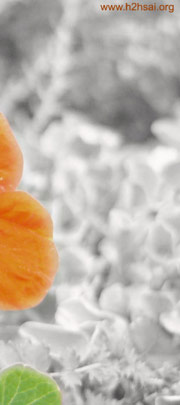CONVERSATIONS WITH SAI
Satyopanishad - Part 24
Direct Directions from the Divine
Dear Reader,
In response to your positive feedback to this section where we have a conversation with the Divine, we continue with Prof. Anil Kumar’s ‘Satyopanishad’ following Dr. John Hislop’s series ‘Conversations with Bhagavan Sri Sathya Sai Baba’ that ended in January 2008.
This series is also in the question-answer format that many devotees prefer, and has answers from Bhagavan on topics as wide ranging as the origin of evil, the goals of human life, and aspects of God – embodied and formless, to price hikes, women’s liberation, vegetarianism, and the generation gap among people of the present times.
Published in two parts by the author, these volumes have 270 questions in all, which are neatly grouped under separate chapters. In this issue, we continue chapter seven, “Sadhana, The Inner Door”.
CHAPTER VII:
Sadhana, The Inner Door
Prof. Anil Kumar: Swami! Renunciation, we feel, is the most difficult thing. We have so many attachments and it is not easy to give them up. Kindly suggest an alternative!
Bhagavan: No, it is very easy. You are wrong if you say that detachment is difficult. In fact, it is simpler and easier to be detached than to be attached. Now, look here! I hold this handkerchief in my hand. I hold it tight in my grip. It is a strain holding it like that for a long time, i.e. holding the handkerchief in the grip. On the contrary, it is very easy to simply drop it. Is it not? So attachment is difficult while detachment is easy.
Prof. Anil Kumar: Swami! Many different types of sadhana (spiritual practices) are suggested and prescribed for seekers and aspirants. They are very confusing and the situation of the present day seekers is that they have almost forgotten what a spiritual practice is. Most often having taken one path, many drop out or discontinue. Why? Kindly tell us the truth of the matter?
Bhagavan: In My opinion, spirituality is very simple and easy. You may find crushing the petals of a rose flower difficult; compared with it spirituality is easier. But unfortunately, today there is none who knows and teaches sadhana.
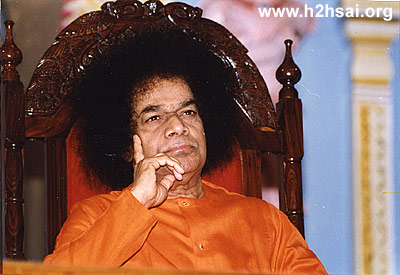 |
What is sadhana? It is a process of removing anatma (non-self from atma, Self). Then, you will have atmanubhavam, the experience of the Self. In other words, the Self, Spirit, Conscience, or atma is the reality. All the rest is non-self or anatma. This is the purpose of spiritual pursuit or sadhana.
You also wanted to know why a chosen spiritual path is discontinued. Understand well that nothing is wrong with sadhana. The mistake is yours. It is your weakness. For example, you boarded the Bangalore bound tram. If you get down in the middle without reaching the destination, whose fault is it? It is definitely not the mistake of the train. It is your fault.
Prof. Anil Kumar: Swami! We are not able to meditate. We do not even know the procedure. What are we to do?
Bhagavan: When the procedure is not correctly known and you are not able to concentrate as you meditate, do not waste time. Do some good work. It is ridiculous sitting down for meditation, while thinking of all sense objects and sensual pleasures. It is purely a waste of time. In fact, if it is true meditation, the feeling, "I am meditating", should totally vanish. The three - 'the one that meditates’, ‘the one on whom you meditate upon' and the 'process of meditation' should be unified. This is called triputi.
"Laziness is rust and dust; Realisation is rest and best" |
Always keep in mind one important thing. You are as much far from Me as I am from you. You should always experience proximity with God and finally identify yourself with Him. The fruit of your meditation depends on this. With conviction that God is everywhere and by loving and serving all, giving up selfishness and self-interest, you will experience the benefit of true meditation and know that your reality is atma, the Self.
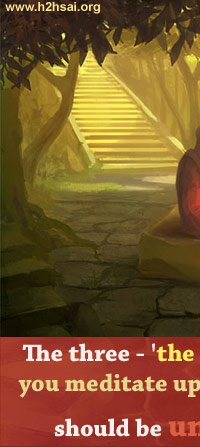 |
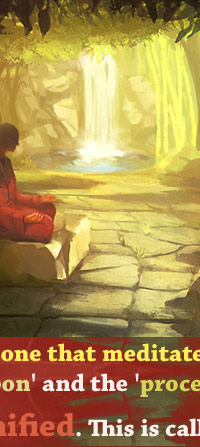 |
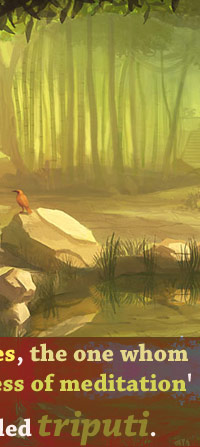 |
One example you might remember about meditation. Here are two tumblers, of which one is full of milk that has to be poured out into the other tumbler. What do you do? You hold the tumbler filled with milk in one hand and the empty tumbler in the other, and slowly pour milk. The two tumblers should be held tight.
If the tumbler with milk is shaking for any reason, the milk spills out. If the other tumbler is not held tight, and starts shaking, you can never collect milk. In other words, both the tumblers must be kept steady. The upper tumbler with milk is God, who should be pleased with your unflinching devotion while the lower tumbler, which represents the devotee should have unwavering faith.
Prof. Anil Kumar: Swami! My mind is not steady. How am I to do bhajans? Without steadiness of the mind, what for are our bhajans?
 |
 |
 |
Bhagavan: The mind is never steady. This is natural. The body may find it easy to be steady and difficult to move and run, the condition of the mind however is just the opposite. The mind finds it difficult to be steady, but easy to run or waver. Body is jada, inert, but the mind is chaitanya, awareness.
You may lie down on your bed, but your mind will go round all places. Here there is one important point that is to be noted.
The mind has no independent existence. It functions only through the body. The mind which goes round different places is not received and responded to by anyone. No one extends hospitality or responds to its behaviour.
It has to come back to the body sometime or the other. Therefore, never stop your sadhana, be it bhajan or meditation. The mind will slowly settle and be steady. Leaves flutter due to wind currents, once it stops, leaves become steady and motionless. The same is the case with the mind.
Prof. Anil Kumar: Swami! Some people are not putting in enough effort in matters of spirituality. They are lazy. Is it proper to be so?
Bhagavan: This is not spirituality at all. "Laziness is rust and dust; Realisation is rest and best". Man is gifted by God with body, mind and intellect for performing karma, action. It is said, Karmanubandhini manusyaloke - Human society is bound by action. Karmame karanam narunaku sukhadukhamilalo (Telugu verse) - It is only action that makes you happy or unhappy. Karma is the cause of janma (birth). For the redemption of life and following righteousness, one has to take to the path of action that gives you the divine experience, brahman.
You may say that you are not doing any karma. Remember that you can't live for a moment without karma. Respiration, blood circulation, etc., are actions, whether you know it or not. You eat food while it is God who digests it. One significant thing is human effort and God's grace are both equally important. These are like the positive and negative wires through which the current flows. Another example is the matchbox. In order to light a matchstick, you have to strike it against the sides of the box.
|
I give you another illustration in support of this. Suppose the cart in which you are traveling turns upside down. You have to get up slowly and lift a wheel to set it right. God's grace will add to your effort raising the other wheel so that the cart comes back to the normal position.
Prof. Anil Kumar: Swami! Some say that satkarma, good action is enough; others argue that puja is essential, but some hold the view that atmavidya (knowledge of the Self) is the only way to liberation. How are we to coordinate and integrate these three? Are these not contradictory to each other? Why should these three be prescribed?
Bhagavan: First, be very clear that they are not contradictory. Performance of good action is karma marga (Path of Action). The three activities you have mentioned are like three different kinds of travel by train. The first is the direct train that takes you to your destination. This is jnana marga, the Path of Wisdom. The other one is, the train in which you have to change to another at a railway junction, as it is not a direct train. This is karma marga, the Path of Action.
But, there are still other trains to which the carriage you board will be connected, and you don't have to get down and change it on the way. This is bhakti marga, the Path of Devotion. You can view these paths in this way.
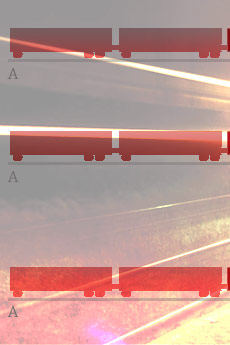 |
 |
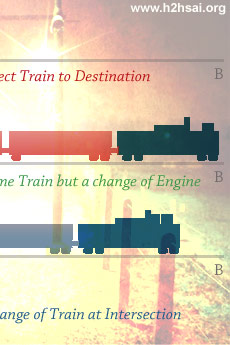 |
Another example, a mother has three sons. She feeds the youngest one, a little one, all by herself. But the second son is a grown up boy who will go straight to the kitchen and have his food served by the cook. The eldest son being an adult can serve food for himself and eat it. Similar is the situation here. The youngest child stands for the Path of Action, the second son represents the Path of Devotion, while the eldest symbolises the Path of Wisdom.
Another example, a king had three wives. He had to be away from his kingdom longer than planned. So he sent a message to his three wives telling them that his return was delayed and also asking them to inform him as to what he should bring home for them as gifts. The first wife said she needed nothing except his safe return. The second wife who was ailing for quite sometime wanted medicines, while the third one who was very fond of jewels wanted the latest designs to be brought. On his return, the king went straight to the first wife and stayed there.
The other two wives came and pleaded with him to visit them also saying, "Oh King! Your return was already delayed. You have been spending much time with your first wife. What about us?" The king replied, "Look! This one wanted my safe return. So I am with her. But you wanted medicines and jewels, and accordingly I sent to both of you what you had asked for."
There are three 'W's. The first 'W' indicates 'Work' or karma marga, the second 'W' means 'Worship' (Devotion) or Bhakti marga, and the third 'W' signifies 'Wisdom', or jnana marga. These three are contained in the name of SAI. 'S' stands for 'Service (karma yoga)’, 'A' for 'Adoration' (bhakti yoga) and ‘I’ for 'Illumination (jnana yoga)’. |
Thus, the first wife who asked for the king himself and none else stands for vairagya, renunciation. The second wife who wanted medicines represents prakritika jnana, material knowledge, while the third one who wanted jewels symbolises prakritika bhakti worldly devotion for worldly gains.
Therefore, different spiritual paths are prescribed and suggested considering the eligibility, temperament, suitability, capability and the samskaras and vasanas (tendencies brought forward from past lives).
The same thing I tell My students. There are three 'W's. The first 'W' indicates 'Work' or karma marga, the second 'W' means 'Worship' (Devotion) or Bhakti marga, and the third 'W' signifies 'Wisdom', or jnana marga. These three are contained in the name of SAI. 'S' stands for 'Service (karma yoga)’, 'A' for 'Adoration' (bhakti yoga) and ‘I’ for 'Illumination (jnana yoga)’.
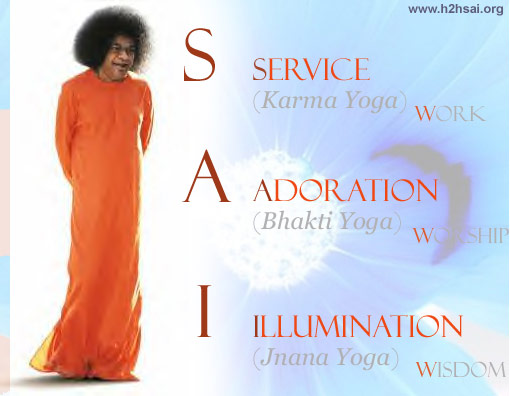 |
Prof. Anil Kumar: Swami! We want to know how a true experience can be communicated.
Bhagavan: Here, there are three steps. First, you should know, jnanatum, then, see drastum, and finally, experience, pravestum.
You know a mango. You go to the market where you see it. That is not enough. You should buy and eat it to experience the taste of it. You can describe what you know and see. But you can't convey your experience.
For instance, if you stand knee-deep in water you can freely talk. If you stand neck deep in water, you can afford to talk. If you drown yourself totally, you can't talk. Can you? This is the state of total experience beyond expression.
Prof. Anil Kumar: Swami! What is the cause of agitation? How are we to get rid of it? What changes are needed to be free from agitation?
Bhagavan: Absence of sathya, truth and dharma, righteousness is responsible for all agitation today. Therefore, people have lost peace and bliss.
One has to live attached to God, anurakti, detached from the world, virakti, with devotion, bhakti, and achieve liberation, mukti, with all your energies, shakti. This is the only solution to problems like agitation, restlessness and conflicts internal or external. |
Modern man has faith neither in himself nor in God. He is blind having lost the two eyes of faith. Human life without faith is a barren land. It is not man, manisi (Telugu) who should change. It is the mind, manasu (Telugu) that has to change. Niti (morality), riti (conduct), and khyati (good name) are essential. Truth or sathya is morality or niti, righteous conduct or dharma is the way of life or rithi, while sacrifice or tyaga is the good name or khyati that you should get.
A man with desires, kama, is never happy.
A man with anger, krodha, will have no friends.
A man with greed, lobha, is cut off from bliss, ananda.
 |
 |
 |
Therefore, kama, krodha and lobha are enemies. The happiness of the vyakti, individual, depends on samisti, the community. The individual has a form. The community has no form. If you respect the individual, it means you are respecting the community. The community is in srusti, the creation.
The Creator is paramesti, God. So it all begins with vyakti, the individual and ends in paramesti, divinity. In other words, God has created this world in which samisti, community consists of vyakti, individuals. Thus, they are interrelated and interdependent. Therefore, in the individual, morality is truth. His conduct should be righteous and his reputation lies in realising God.
Bhagavan Buddha speaks of certain aspects of individual sadhana. Buddha said, samyakdrsti, good vision, is necessary. "Your vision must be pure and sacred". This will lead to samyak sravanam, good listening. These two great qualities imprinted in the heart induce samyak bhava, good feeling. This prompts and promotes samyak kriya, good action. Therefore, at the individual level, when good vision, good listening, good feeling and good action are followed, the community will be ideal. There will be no disquiet and agitation.
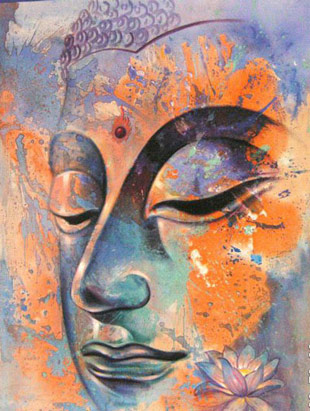 |
One has to correct one's lapses and mistakes. You should never speak ill of anybody. There is another episode connected with Buddha. Buddha mercifully accepted the invitation of a prostitute to dine at her residence.
While He was proceeding, the village head came and objected to His visit to her residence, as she was a bad character. Buddha caught hold of his right hand and said, "Now, clap your hands if you can". The village head said "Oh, Lord! How can I clap with one hand while you hold my right hand?"
Buddha smiled and said, "You can't clap with one hand. You have to join both the hands. Similarly, you have said that the woman is of loose character. Who has made her like that? It is you people who have spoiled her". Then the village head and other elders fell at His feet and followed Buddha. The woman too changed her behaviour and became His devotee.
During that time another significant event happened. One day Buddha was tired and taking rest. So He asked one of His disciples to address the gathering that evening on a spiritual topic. The disciple got up, and while speaking in praise of his master, Buddha, he said, "No master like Buddha was ever born before him nor would be born later". Everyone clapped.
On hearing this, Buddha came into their midst, and gently said, "How old are you?" How do you know that no one like your master was born before and would be born in future? How can you speak about the future? Many noble people lived in the past and are now living in the present, and also will be born in the future". Thus, He indicated indirectly the advent of Avatars or divine incarnations.
One has to live attached to God, anurakti, detached from the world, virakti, with devotion, bhakti, and achieve liberation, mukti, with all your energies, shakti. This is the only solution to problems like agitation, restlessness and conflicts internal or external.
Prof. Anil Kumar: Swami! We have been thinking that all things can be achieved through Self-confidence. In your discourse that day you mentioned Self-protection and Self-punishment too. Kindly explain these.
Bhagavan: Quite often I mention to our boys these things: Self-confidence, Self-satisfaction, Self-sacrifice, and Self-realisation. In addition to these, Self-protection and Self-punishment too are necessary. Self-protection is the capacity to face anything with Self-steadfastness.
Then Self-punishment involves the faculties of examining one's mistakes of one's own accord, and of refraining from those mistakes through firm resolve. Self-punishment is holding in check through repentance possibilities of those mistakes.
"Quite often I mention to our boys these things: Self-confidence, Self-satisfaction, Self-sacrifice, and Self-realisation. In addition to these, Self-protection and Self-punishment too are necessary. Self-protection is the capacity to face anything with Self-steadfastness". |
Prof. Anil Kumar: Swami! In the classes, we have learnt about self-awareness. How can our tendency be changed? Kindly teach us the appropriate technique.
Bhagavan: I asked you, "What does 'self-awareness' mean?" Someone said, "understanding". This is not the correct answer. This word can be interpreted in two ways. In the worldly sense, it refers to looking at oneself, i.e., selfishness. Knowledge concerning this can be called "self-awareness". Spiritually, its meaning is quite different. In spiritual terms, all that is, is merely the Self.
The key to all actions and all experiences lies within the Self. The body, mind, senses, and intellect are just instruments of the Self. Without the Self, these are useless. These are to the self what the head, leg, hand, and so on are to the body. Now I asked you what is meant by 'tendency'. Someone replied, "attitude", and another "nature". These are not correct. It is an innate orientation. Tendency exists in man in three modes.
Their names are animal tendency, human tendency, and divine tendency. Of these, the first runs after sense objects. The second is marked by discrimination, though coloured by desires. The third is totally devoid of desires, attachment, and 'I' and 'Mine'. There may be an attachment and sense of 'I' and 'mine' in life, but life is not for the pursuit of these.
You asked for an appropriate technique. When I asked for the meaning of that word, one called it 'method,' and another, 'procedure.' These two are not correct. The technique is vidhi vidhanam. What ought to be done is vidhi; how to do it is vidhanam. There is only one technique for Self-awareness. You have to have awareness that you are the atma, the Self. I refer to it as Constant Integrated Awareness. This Self or Atma is truly God. You are the embodiment of God. Here you should remember three things:
i) What is it that once it is had, is never lost? Jnana. In other words, when jnana occurs, that is, when there is awareness, it never is lost.
ii) What is it which once lost can never be had again? Ajnana, ignorance. When once ajnana is lost, you cannot have it again.
iii) What is it that is neither lost nor had? Brahmam, Self, Atma, this may be called 'Self-Awareness.'
 |
 |
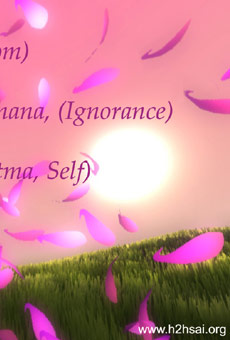 |
Prof. Anil Kumar: Swami! How are we to realise the existence of divinity, and by what intimation are we to cognise it? Swami is pleased to refer to it in the charming phrase, "Constant Integrated Awareness". How are we to achieve this Awareness?
Bhagavan: The idea that all forms and all names belong to God is verily Constant Integrated Awareness. The experience of sarvam vishnumayam jagat - the world is pervaded by Vishnu, is but Constant Integrated Awareness. God can be experienced in any form, at any time or place.
The life of Tulasidas illustrates this beautifully. He could not recognise God even when He approached him and talked to him. One day Tulasidas sat under a tree, grinding a piece of sandalwood on a mortar to prepare the paste. Right then, two cowherd boys came there and asked him, "Grandfather! Will you give us some sandal paste?"
The idea that all forms and all names belong to God is verily Constant Integrated Awareness. The experience of sarvam vishnumayam jagat - the world is pervaded by Vishnu, is but Constant Integrated Awareness. God can be experienced in any form, at any time or place. |
Then, Tulasidas replied, "My children! I am preparing this for Lord Sri Ramachandramurthi". Two parrots, perched on a bough of that tree, observed this, and commented, "For whose sake is all this paste? Why doesn't he realise it?" Tulasidas heard these words. He knew the language of the birds.
 |
The next day, while he was preparing the paste, the two cowherd boys turned up. This time, even without asking him, they took some sandal paste into their palms, applied it to the forehead, and left. Tulasidas who had noticed this was dumbfounded. This time too he heard the birds’ comments from the branch of the tree, "Aha! What a wonder!
Those for whom the sandal paste was prepared, had themselves come, and received it! What fortune!" As he knew the language of the birds, Tulasidas realised that the boys who had adorned themselves with the paste were, indeed, Rama and Lakshmana. Out of ignorance, he had at first denied them.
You may have heard of Vemana too. He was a thinker who belittled worship offered to stones and idols. He used to doubt, "God, who pervades the whole world, how can He be inside stone statues?" He used to make fun of idol worshippers. One day, his elder brother's daughter, whom he loved dearly, passed away.
Grief stricken, he kept on gazing at the little girl's picture hanging on the wall. His elder brother's wife was observing all this. One day, she threw down the picture. It broke into pieces. This was too much for Vemana to bear.
Then, she said, "My son! My girl is no more, isn't she? Why do you cry over a broken picture?" Vemana replied, "Mother! Though she is gone, her picture was here, wasn't it? Looking at it has been some consolation for me. That is why when it broke into pieces, I am grieving ever more." Then his elder brother's wife counseled him admirably, "My son!
It is very true that God is present everywhere. But, the devotee delights in seeing Him and worshipping Him in an idol as well. Just as you consoled yourself looking at the picture even though she whom you love is no more, the devotee invokes God in an idol, and offers it worship."
Straightaway Vemana grasped her message, and the secret behind idol worship. In this way, the experience of visualising the Supreme Lord in all places, times, and creatures is truly Constant Integrated Awareness. This can also be called the existence and intimation of Divinity.
Dear Reader, did this article inspire you in any way? Would you like more of such conversations with the Divine? Please share with us your reflections by writing to h2h@radiosai.org mentioning your name and country. Thank you for your time.




